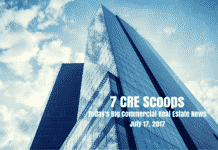With a commercial real estate cycle rolling steadily toward its decade mark, investors are evermore conscientious of the returns they are currently getting, and now stand to get. It’s a mixed bag of news — deal volume is down but pricing and cap rates have held steady thus far this year.
According to the latest U.S. Capital Trends report by Real Capital Analytics, investment volume is at its lowest since 2011, but pricing has held its ground and cap rates are flat for most sectors.
As recorded in CBRE’s First-Half 2017 Cap Rate Survey, office and hotel assets showed “modest increases” in cap rates in the first half of this year, but multifamily and industrial assets registered decline in cap rates. The retail sector, meanwhile, has demonstrated the greatest overall increase to cap rates in the first half.
As the second half of the year approaches, performance of investments against the 10-Year Treasury is of course being scrutinized. Investors are eyeing the fate of monetary policy as well, especially as the question of Chair Janet Yellen’s tenure after February remains unanswered. In a speech at the Jackson Hole conference in Wyoming on August 25, Yellen summarized her perspective on financial markets, and it’s unclear whether her emphasis on the importance of regulation ultimately meshes with a Trump White House.
Where commercial real estate investors go from here is difficult to discern, but it’s worth looking at data on cap rate performance in the hopes that future outlook can tend toward the predictable.
Respondents to CBRE’s first-half 2017 cap rate survey expect pricing stability to remain stable in the second half of this year, and the consensus is that any cap rate changes will arise as a modest increase (less than 25 bps).
In its 2017 commercial real estate investor survey, CBRE found the type 5 concerns for investors to be as follows: global economic shock that undermines occupier demand (22%); faster-than-expected interest rate rises (21%); overpriced property and potential bubble (15%); overbuilding that leads to excessive supply (10%); and local economic shock that undermines occupier demand (10%).
CBRE’s data on cap rate and 10-Year Treasury spread per asset are presented in chart format following a brief summary of the commercial real estate firm’s sector findings.
Multifamily
Both infill and suburban multifamily assets saw cap rate performance that CBRE classifies as stable.
Across the board at both infill and suburban multifamily, California cities took the crown for tightest pricing returns in the first half. San Jose, San Francisco, San Diego and Los Angeles all had the lowest cap rate for stabilized class A infill in the U.S. at 4.00%, CBRE researchers write. San Jose, Orange County, San Francisco and Los Angeles, San Diego, Oakland and the Inland Empire all experienced cap rates under 5% for stabilized class A suburban.
Looking ahead to the second half of the year, about 73% of respondents expect no cap rate change for multifamily infill product, and 22% expect an increase less than 25 bps.
In regards to suburban multifamily, 79% of respondents expected cap rates to remain the same, and 15% see a slight increase.
Office
CBD office cap rates recorded little to no movement in the first half, but increases could be found in Boston, New York and Washington, while compression was noted in smaller metro areas lie San Antonio and Cincinnati. Three-quarters of respondents to CBRE’s survey forecast no change to value-add and stabilized CBD office markets through the next six months.
Suburban cap rates outpaced CBD cap rates in the first half, increasing at double the rate of their urban counterparts. Atlanta, Chicago, Denver, Detroit, Jacksonville, Miami/South Florida, Phoenix, Pittsburgh, Portland, Salt Lake City, St. Louis and Tampa are among markets wherein suburban office assets may see cap rate increases going into the second half, showing no clear geographic trend. Just over 30% of respondents see a higher cap rate in suburban office markets as opposed to CBD in the second half, but the increase is still expected below 25 bps.
Retail
Although grocery-anchored neighborhood and community centers have enjoyed a reputation akin to retail darling, cap rates for these stabilized properties grew 11 basis points in the first quarter. CBRE is forecasting a cap rate increase on stabilized neighborhood/community centers in the second half. But returns on value-add grocery-anchored plays are up, CBRE says, noting that “Returns on cost for value-add acquisitions of neighborhood/community centers rose by 20 bps to 8.98%. All market tiers saw a similar level of rate expansion— increases ranging from 17 to 20 bps. By class, returns on cost expanded more for Class C value-add centers (24 bps) than Class B (18 bps).”
For power centers, tinged by oft-sensationalized reporting on the death of malls, cap rates overall are predicted to increase at least moderately by a majority of respondents. “Overall, power center cap rates are expected to widen in H2 2017. For stabilized assets, 31% of survey respondents expect no change. The majority (66%) anticipate increased cap rates (37% modest increases of less than 25 bps and 29% larger gains of 25+ bps). The balance (3%) expect a slight compression in rates,” CBRE researchers write.
The cap rates for high-street retail, a sector arguably most affected by market rents, are notoriously low. “Among high street markets, San Francisco and Los Angeles had the lowest cap rates (3.75%) in H1 2017, while Las Vegas had the highest (5.25%). Just over half of all markets experienced no change in cap rates in H1 2017. San Francisco was the lone market to experience high-street cap rate compression (-50 bps). Driven by negative rent growth, Manhattan cap rates rose the most (100 bps) in H1 2017. Chicago had the smallest increase of 13 bps,” CBRE says.
Stabilized high street retail cap rates are expected to increase by ~25 bps in Chicago and Manhattan, yet compress in Miami.
Industrial
The effects of ramped-up industrial demand from 2015 to 2016 can now be seen in the numbers. Cap rates compressed across stabilized industrial asset acquisitions, dropping 7 bps between the second half of 2016 and the first half of 2017, according to CBRE. That means investors appear to be more comfortable with older properties. On the value-add side, CBRE says that “after somewhat sharp drop in value-add returns on cost from 2013 to 2015, rates have leveled off.”
Just 5% of survey respondents predict an increase of less than 25 bps over the second half of the year. And 18% see cap rate compression occurring in stabilized industrial assets, as a result of tight vacancy and higher rent growth.
Hotel
Irregardless of hotel class, all hotels situated in CBD areas saw a slight bump in cap rate ranging from 4-8 bps, according to CBRE. Over the second half of the year, respondents expect increases in cap rates, following alongside the 10-Year Treasury.
CBRE says CBD hotel cap rates are forecast to increase in “energy-industry-dependent locations, and across market segments with an overweighting of construction, such as select-service. Many downtowns are receiving substantial amounts of new supply.” In the same vein, respondents feel cap rates for suburban hotels in energy-industry-dependents will also increase in the second half.
“The historical charts reveal a moderate downward movement in suburban, full- service cap rates until H1 2015, followed by a reversal for all metro tiers and market segments since then. The H1 2017 survey indicates a softening upward trend,” notes CBRE.
What follows is CBRE data on cap rate performance metrics for the first half of 2017 across all classes of commercial real estate:


















